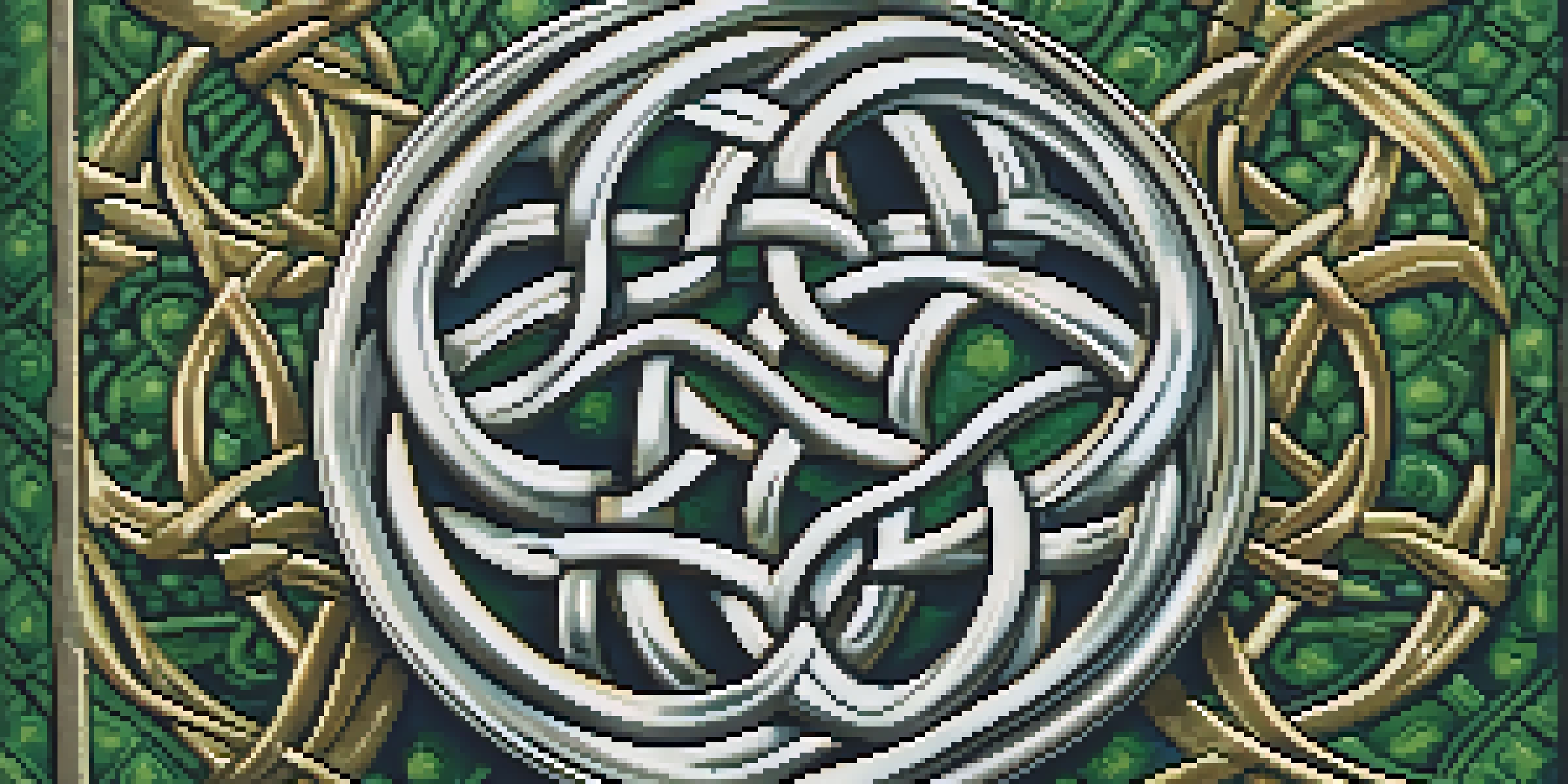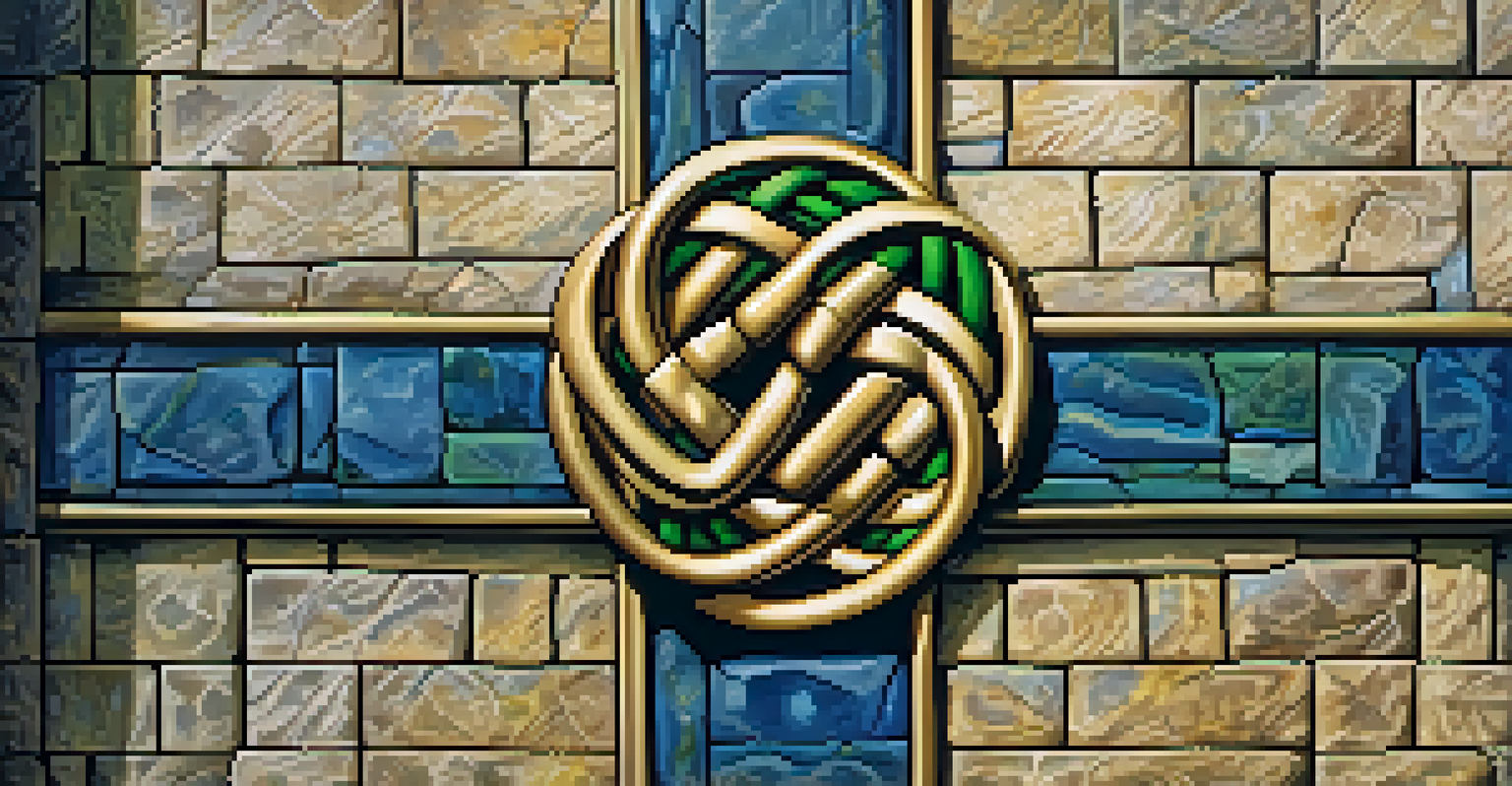Celtic Knotwork: Discovering the Art of Intricate Designs

Understanding the Origins of Celtic Knotwork
Celtic knotwork has deep historical roots, dating back to the early medieval period. Originating in Ireland and Scotland, these intricate designs were often used in manuscripts, metalwork, and stone carvings. The knots were not just decorative; they were also symbolic, representing concepts like eternity and interconnectedness.
Art is the most beautiful of all lies.
These designs reflect the spiritual beliefs of the Celts, intertwining nature and mythology within their art. For example, the endless loops of the knots signify the cycle of life and death, highlighting their belief in an eternal existence. This cultural significance adds a layer of depth to the visual beauty of the artwork.
As you explore Celtic knotwork, you'll notice its evolution over centuries, adapting to various artistic styles while maintaining its core symbolism. This adaptability has helped keep the art form alive, allowing it to resonate with new generations and cultures.
The Symbolism Behind Celtic Knotwork
At the heart of Celtic knotwork lies a rich tapestry of symbolism, making each design unique. The continuous loops often represent the interconnectedness of life, love, and nature, conveying a sense of unity. This idea is particularly poignant in the context of Celtic culture, where community and relationships are highly valued.

Different patterns can also symbolize various aspects of life. For instance, the trinity knot often signifies the interconnectedness of mind, body, and spirit, while the shield knot is believed to offer protection. Understanding these symbols can deepen your appreciation for the art form and encourage a more personal connection.
Celtic Knotwork's Rich Symbolism
Celtic knotwork embodies deep symbolism, representing concepts like eternity, interconnectedness, and the harmony of life.
Additionally, the use of natural motifs—such as leaves and animals—further emphasizes the Celtic respect for nature and the world around them. This blend of symbolism and nature creates a powerful narrative that speaks to the heart, allowing viewers to engage on multiple levels.
Common Patterns and Their Meanings
Celtic knotwork features several familiar patterns, each with its own distinct meaning. The most recognized is the endless knot, characterized by its interwoven loops that have no beginning or end. This design embodies the concept of eternity, making it a popular choice for jewelry and tattoos.
The more we learn about the past, the more we can understand the present.
Another notable pattern is the triskelion, which consists of three spirals. It symbolizes movement and the passage of time, often interpreted as representing the past, present, and future. This dynamic design captures the essence of motion, reflecting the ever-changing nature of life.
Lastly, the double knot is a design that speaks to duality and balance. It often represents the harmony between opposing forces, such as life and death or light and dark. By understanding these common patterns, you can appreciate the intricate meanings woven into each piece of artwork.
Celtic Knotwork in Modern Art and Design
While Celtic knotwork has ancient origins, it continues to inspire modern artists and designers today. Many contemporary creatives incorporate these intricate patterns into their work, blending traditional techniques with modern aesthetics. This fusion not only keeps the art form alive but also introduces it to new audiences.
You can find Celtic knotwork in various modern applications, from tattoos and jewelry to home décor and graphic design. Its timeless appeal resonates with many, making it a popular choice for those seeking to connect with their heritage or simply appreciate the beauty of the designs.
Modern Applications of Knotwork
Today, Celtic knotwork inspires contemporary art, jewelry, and tattoos, blending traditional designs with modern aesthetics.
Moreover, the resurgence of interest in traditional crafts has led to a renewed focus on knotwork in artisanal pieces. Artists are experimenting with materials and techniques, ensuring that Celtic knotwork remains relevant in today's artistic landscape.
Techniques for Creating Celtic Knotwork
Creating Celtic knotwork requires a blend of artistic skill and methodical planning. The process often begins with sketching out the design on paper, allowing the artist to visualize the interconnected patterns. This stage is crucial, as it sets the foundation for the intricate weaving of lines.
Once the design is established, artists typically use tools like pens or carving instruments to bring the knotwork to life. Precision is key, as the beauty of each piece lies in the seamless flow of the lines. This meticulous attention to detail ensures that the final design captures the essence of Celtic artistry.
As artists gain confidence, they often explore various mediums, such as wood, stone, or metal, each adding a unique texture and depth to the artwork. The diversity of materials allows for endless creativity, enabling artists to express their interpretation of Celtic knotwork in exciting new ways.
Celtic Knotwork in Jewelry and Tattoos
Jewelry and tattoos are two of the most popular ways to showcase Celtic knotwork. The intricate designs lend themselves beautifully to adornments, often symbolizing personal beliefs or connections to heritage. For many, wearing Celtic knotwork is a way to honor their ancestry and celebrate their roots.
Tattoo enthusiasts are particularly drawn to the symbolism and artistry of knotwork. Many choose designs that resonate with them personally, whether it's a trinity knot for spiritual balance or an endless knot for eternal love. These tattoos serve as a permanent reminder of the values and connections that matter most.
Preserving Celtic Craft Traditions
Efforts to preserve Celtic knotwork include workshops and community events that encourage the transmission of techniques to future generations.
Similarly, jewelry pieces such as rings, pendants, and bracelets featuring knotwork designs are cherished for their beauty and meaning. They make thoughtful gifts, often symbolizing important relationships or milestones. Whether through ink or metal, Celtic knotwork continues to be a powerful form of personal expression.
Preserving the Legacy of Celtic Knotwork
As Celtic knotwork remains a beloved art form, efforts to preserve its legacy are more important than ever. Organizations and artists are dedicated to keeping the traditions alive, offering workshops and resources for those interested in learning the craft. This commitment to education ensures that the skills and knowledge surrounding knotwork are passed down through generations.
Moreover, many contemporary artists draw inspiration from traditional designs while infusing their own creativity into the pieces. This blend of old and new not only keeps the art form relevant but also encourages innovation within the craft. By embracing both heritage and modernity, Celtic knotwork can continue to evolve.

Community events and exhibitions celebrating Celtic culture also play a vital role in preservation. These gatherings provide a platform for artists to showcase their work and for enthusiasts to learn about the history and techniques of knotwork. Engaging in these activities fosters a sense of connection and appreciation for this intricate art form.